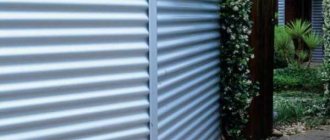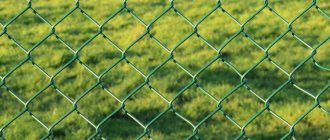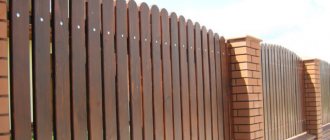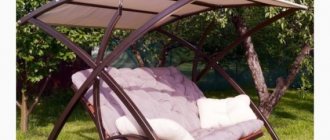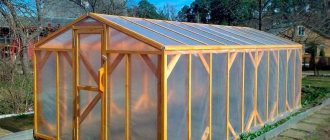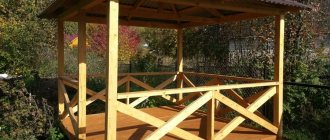The most popular types of residential fences are steel picket fences and fences made from wooden picket fences.
A fence fence is a special structure made of support strips and vertical narrow boards that are installed for protective or decorative purposes.
Characteristics of the picket fence:
- reliability and strength;
- long service life;
- fast production in a few days;
- optimal prices for picket fences.
This article describes the types of picket fences and methods of their production.
When purchasing wooden raw materials, pay attention to its smell. If you smell a damp, moldy smell, it means the wood has begun to rot.
To produce steel fences you need:
- welding equipment;
- electric drill;
- screwdriver;
- self-tapping screws;
- Bulgarian;
- pickets;
- level;
- supports and concrete;
- Boer;
- concrete mixer;
- roulette.
Distinctive features
A metal picket fence is made from sheet steel. Prepared planks are used to fence the local area. For installation, racks and cross bars are required to hold the entire structure together. It will look like a regular wooden fence.
The metal picket fence can be from 0.4 to 1.5 mm thick, but there are other options. To prevent rust, you need to coat the product with a special compound or a layer of zinc. After this, the fence can be painted.
Methods for fixing pickets
If the structure is needed for reliable protection of the house and is located on the street side of the site, then we recommend that you take into account that:
- To install a blank canvas and completely close the estate from prying eyes, you should buy pickets more than 1.8 m long, placing them from the ground at a distance of 3–5 cm.
- If visibility of the area is not important to you, then it is enough to purchase planks 1.5 or 1.25 m long and secure them with gaps.
Now let's look at what methods of fixing a picket fence are used more often.
Vertical
A generally accepted option for installing planks. For construction, you do not need to know special instructions and attach additional transverse joists to increase the rigidity of the structure.
Each plank is fixed in a vertical position to the joists with screws or rivets. This can be done with gaps in one row or you can design a blank canvas in the form of a checkerboard fence.
Horizontal
Not as popular as the previous type, but if you follow the instructions, the fence will be no less attractive.
Installing picket fences horizontally is much more difficult. It will be necessary to attach additional poles, which often must be of non-standard shape. If this is not done, the planks will begin to sag, which will lead to deformation of the entire structure.
And an increase in the amount of materials for construction means an increase in the total cost of the fence.
Checkerboard
Another name is double-row. The planks are mounted to the transverse joists on both sides so that they overlap each other by at least 1 cm. To do this, the step between the stripes is made slightly smaller than their width. The fence turns out to be almost continuous and what is happening on the site is visible only from a certain angle.
For a completely blank canvas, it is necessary that the pickets overlap each other by half.
The disadvantage of checkerboard is that the material consumption per 1 linear meter increases by 50%.
In one row
An economical option for fastening picket fences, since the strips of material are fixed in one layer. Often gaps up to ⅔ of their width are left between the slats, but this is not critical. The step between the elements may be greater, or they may be attached closely.
Disadvantage: due to the gaps, the area remains completely visible.
Advantages of a metal picket fence
- Long service life. A metal picket fence will last, on average, 30 years, and with careful care – about 50 years.
- Sustainability. When coated with special products, the metal picket fence will withstand any weather conditions. Additionally, it has good resistance to mechanical damage.
- Easy to install. There is no need to pour a foundation for the construction; you can handle the installation yourself.
- Compatibility with other materials. To create a unique design, wood or brick is suitable.
- Such a fence does not require maintenance; it is only necessary to update the color every few seasons. The metal is not subject to fire and has small dimensions, which facilitates its rapid transportation.
Compared to conventional corrugated sheets, metal picket fence has a high cost, but it pays off with a high service life and structural strength.
What is a European picket fence?
These are vertical metal fencing strips made of thin profiled steel sheet with a protective and decorative polymer coating. They are mounted on frames made of posts and crossbars with small intervals, and have a very large color palette. Such strips are attached to the supports with metal screws. A gap is left between the structural elements, and the wider it is, the more transparent and airy the fence appears.
Metal Euro picket fences for building a fence are a relatively new material on our market and have just begun to gain popularity.
Advantages and disadvantages of a picket fence
Advantages:
- aesthetics. The appearance of the fence is neat, stylish, beautiful, and goes well with brick or stone pillars and base. A wide selection of colors and patterns with wood imitation allows you to choose a shade that is ideal for the design of your home and site. Mostly natural brown and green tones are used, but you can choose colored or white;
- durability. In countries where such fencing has been used for a long time, its service life reaches 30-40 years (subject to installation technology);
- strength. Bent profiled metal withstands pressure well;
- corrosion resistance. The polymer coating reliably protects the surface;
- immunity to fungi, bugs, mold, no swelling;
- protective properties - it is almost impossible to overcome a fence without a top decorative strip. Sharp thin metal makes it difficult to grasp the top of the fence - you can seriously injure your hands;
- ease of installation - you can do this work yourself;
- low cost;
- Low weight makes it easy to transport and store the planks.
There are practically no disadvantages to a metal picket fence. The only weak point is the low resistance to burglary attempts (after all, this is not a concrete slab). In addition, there are design restrictions - it is a “thing in itself”, and it is difficult to combine it with forged parts, wood, and polycarbonate.
Types of materials for picket fences
Thanks to the various sizes of metal picket fences, it is possible to design original designs. The strips are made from steel strips that have been processed in a rolling mill.
- Another type of material is metal profile.
- It is considered the most budget option, since the metal sheet is not processed in a rolling mill, but is cut independently.
- A picket fence made in this way will be less durable and have dangerous edges.
- A sheet bending machine is not able to make all the planks the same, which is why the fence will be less strong.
The quality of the fence will depend on the material from which it was made. Most often, cold-rolled sheets are used for picket fences, but sometimes hot-rolled sheets are also used for budget options. In both options, the planks must be treated to increase their service life.
Types of Fills
There are several options for filling the span between the slats. The final cost calculation for the fence will depend on the method chosen.
It is easy to change individual parts of the fence.
Important! There are no clearly defined government or technical standards for slat gaps. The choice is entirely up to the owner.
When choosing the distance between the slats and the method of fastening, the following factors influence:
- the desire to have a “translucent” fence - greater ventilation and illumination, but also visibility from neighbors;
- the budget allocated for creating the barrier - the larger the gap, the cheaper the structure.
Important! Experts advise calculating the clearance between the slats relative to their width. This way the whole structure will have a harmonious appearance.
In the event of a malfunction, it is enough to unscrew the roofing screw or pull out the rivet, and then install a new element of the same color and structure.
Having calculated the budget and decided whether the fence will be solid or with gaps, you need to choose the type of filling:
- Simple, one-sided arrangement of pickets.
- Double sided fence.
- Single-sided angled mounting.
- Double-sided angled mounting.
- Installation according to the type of blinds.
- Simple single installation with attaching the strips to a wall made of corrugated sheets (used for gates).
- Individual scheme of the angle of inclination of the slats.
Important: any type of picket fence is attached only from the front side. Additionally, pay attention to the profile.
A wide variety of different design solutions for residential buildings prompted us to expand the range of picket fences.
Types of coating
In addition to coating with a layer of zinc, another coating is applied to the metal picket fence, which comes in two types.
- Polymer. Protects against rust and mechanical stress for up to 20 years.
- Powder. This is a budget option, however, it requires an anti-corrosion coating, otherwise the metal may rust.
After coating the metal picket fence with zinc, you can begin applying paint. You can paint the fence yourself, or purchase a factory-painted picket fence, a wood-look metal picket fence, with patterns, etc.
Interesting design options for the top of structures
Most often found:
- Ladder. The planks alternate with each other. They put one longer, the other shorter, or vice versa.
- Wave. Suitable for sectional assembly. The top is made in a wavy shape.
- Trapezoid. The top of the fence is formed in the form of a trapezoid.
- Herringbone. The planks form a cone, which is very similar to the crown of a spruce tree.
- Arc. The upper cut is made convex or concave.
- Canyon. Long planks are installed along the edges of the span, the height of which gradually decreases as they approach the center.
- Peaks. The upper part resembles the shape of peaks, and there can be several of them in one section.
Less common is the design of the top line like a pyramid or wings.
The unusual spans will be complemented by a stone or brick base.
Size of slats
The top of the metal picket fence is available in three options: flat, semi-oval, or a designer version.
It is advisable that the edge be processed, otherwise it is easy to get injured on the fence.
The bar itself is available in three versions:
- Rectangular profiling. The most common type. The number of ribs must be at least 3.
- Longitudinal profiling. More durable and aesthetic than the previous option.
- Semicircular. It is rarely made and has its own production difficulties.
The dimensions of the planks range from 0.5-3 m. The width is 10-12 cm. The thickness of the plank determines whether it will need a foundation or not.
Popular manufacturers
Below are 4 metal picket manufacturing companies whose products are most often purchased.
Grand Line
The company is popular both in the Russian and European markets. Produces various products from metal profiles and PVC:
- corrugated sheeting;
- metal tiles;
- siding;
- fence;
- soffits;
- drainage systems;
- facade panels;
- standing seam, composite roofing.
All products are certified.
TPK Center Metalroofing
Produces and sells construction materials.
The Euro picket fence is made of steel 0.5 mm thick. The edges are rolled. Phytoresistant (does not fade in the sun), does not rust. Each plank is wrapped in film. The service life of the products reaches 50 years.
All products are certified.
EugeneST
The group of companies makes and implements:
- metal tiles;
- thin sheet steel with polymer coating;
- corrugated sheeting;
- metal siding.
EugeneST LLC produces metal picket fences under its own brand “Barrera”.
Color spectrum
With modern technologies, you can design in any color.
Most common colors:
- Green. Blends well with plants in the local area.
- White. Requires frequent maintenance, looks great with the French Provence style.
- Chocolate. Combines with other flowers and trees.
- Grey. Suitable for any design.
The assembly of the structure depends on the fixation methods and has three options:
- Vertical. The most common type of installation. It is permissible to leave gaps between the planks, or fasten them together without gaps.
- Horizontal. Not the most common option, but also quite relevant. Installation requires a lot of time and effort.
- Chess. Installation occurs vertically in two rows, leaving no gaps between the rows. Suitable for those who like privacy.
- A unique approach. You can create a herringbone or wave from the planks. It all depends on your imagination.
If you have no experience, it is better to order the installation of a picket fence from a construction company. You can install the fence yourself without resorting to outside help.
For independent work you will need a metal profile and special scissors. The difficulty is that the edges of the planks must be even, which will require additional time. The best option is to purchase a ready-made fence and install it yourself.
Finishing work
When the fence is ready, you can start painting it. The natural color of the wood pleases the eye and seems ideal. But if he spends some time in the rain, snow or scorching sun, no trace of this beauty will remain. Therefore, a prudent owner is obliged to choose a paint whose color he likes and fits into the overall exterior of the house, or stain . The latter, in combination with colorless varnish, will help to imitate wood of any species or “preserve” the original color.
Moreover, it is better to apply the paint with a brush, and first spray the stain with a spray bottle.
The top of the fence can be given an interesting wave or semicircle shape. To do this, you will have to arm yourself with a pencil and a drawing tool. You should not rely on your “diamond eye”, since the consequences of failure will be very difficult to correct. Decorative elements of various shapes made of wood or metal are suitable for decoration on the front side of the fence.
Good to know: If the fence is designed with regular even boundaries, then ropes need to be pulled along the lower and upper edges. Then there will be no problems with the correctness of the lines.
Options for decorative solutions for the top of the fence.
For those who like to profit from other people's goods, picket fences with a conical top will cause great inconvenience. Also, nothing prevents the owners from stringing barbed wire on top.
This wooden creation should be crowned with a reliable gate or gate - it all depends on the wishes of the owners. In any case, the “doors” in the fence must be locked. If necessary, there can be several gates.
If the person erecting the fence is the happy owner of an entire farm, and on the site, in addition to the house, there are hectares of beds, a mini-farm, a pasture and a playground, then it makes sense to consider a picket fence for zoning the territory. Low wooden fences around flower beds and bushes also look very nice.
In order for site owners to be inspired by the idea of building a new fence, the photo below shows beautiful wooden picket fences.
Classic. Arched spans, pillars with decorative tops.
Another solution for the top of the pillars. A small detail is a different image.
Reverse arch.
A gate made of the same material and an arch above it fit very nicely into the fabric of the picket fence.
Above the gate you can place not only an arch, but also a pergola.
"Flowing" fence. A wooden picket fence is one of the few fence options that can easily accommodate complex terrain.
Step solution.
Luxurious option on a stepped base.
Sometimes an unusual color sets the style.
A radically different style solution. Although the focus is also on color.
A bright yet classic color option.
Wood is rarely painted in dark colors, but why not.
Unusual black fence.
Chameleon fence. The artistic coloring makes it that way.
Another creative color option.
Fence colors with a nod to colonial style.
The original version of the spire. Nothing prevents you from coming up with and implementing your own.
Variations with the direction of the pickets are possible. They are mounted not only vertically, but also horizontally.
….A mesh option is also possible.
It is difficult to say how long the entire fencing installation process will take. If the materials are prepared, the area is small, and there are helpers, then you can get it done in a day. A team of specialists will need the same amount. A week is not enough for a person who does everything alone and has to fence off a large area.
DIY picket fence installation
For installation you will need fasteners and diagrams, which are most often sold together with the metal picket fence.
For installation you will need:
- Shovel or drill. Necessary for creating a trench.
- Welding machine. Needed for welding horizontal strips with supports.
- Screwdriver. Needed for fixing planks with guide parts.
- Construction level, tape measure.
Materials needed:
- Hollow pipes for vertical supports.
- Horizontal guides.
- Fence.
- Self-tapping screws.
- Soil mixture.
- Dye.
- Mixture for pouring the foundation.
Recommendations and common mistakes
Installing a fence is not very difficult, but even experienced professionals can make mistakes. In practice, the following mistakes most often occur:
- Wrong time of year - best to work in late spring or summer, when the ground has fully warmed up.
- Insufficiently thorough control, from marking to installation of poles (maintaining verticality and height).
- Weak foundation - this error occurs when the soil is sandy. It is quickly washed away by water.
- Often, wooden supports are simply immersed in concrete, as a result of which they quickly rot due to moisture. To prevent this from happening, the bases should be thoroughly impregnated with bitumen.
- Gates and gates need to be planned in advance to take into account the driveway, distance from the entrance to the house and other factors.
Installation of metal picket fence
In places where the fence will be built, you need to drive in pegs and stretch the construction cord.
- Mark the installation locations of the support pillars.
- At the marked points, holes of approximately 60 cm are dug.
- Pipes are installed in the pits and driven in approximately 40-45 cm.
- The pits are concreted.
- The cross beams must be welded to the vertical pipes.
- Next comes the installation of the planks.
- The planks are fastened with galvanized screws.
The fence is covered with primer and paint.
Hedge
The most spectacular type of front garden fencing.
For these purposes you can use:
- Evergreen flowering shrubs (medium height hedge): holly, strawberry tree, boxwood, heather, euonymus, barberry and other species.
- High fences: thuja, spruce, pine.
- Long flowering shrubs: buddleia, spray rose, garden jasmine and other flowering bush plants.
Depending on the style of the site and preferences, you can leave the bushes in their natural form. To design areas in regulatory styles, with clear geometric shapes, shrubs are trimmed. In this context, privet, boxwood, and holly will look good.
A hedge can act as an independent fence, or in combination with a permanently installed fence.
Coniferous shrubs for hedges around the front garden Source ap.dnsfor.me
Photo of a metal picket fence
Horizontal arrangement of panels
Panels are attached in this way less often, but visually such a fence looks very attractive and unusual. To position the picket fence vertically, you will need to make a frame frame, which will entail an increase in costs. Regardless of the type of frame, metal elements must be painted with a special protective compound. This will protect the frame from exposure to moisture and the development of corrosion. The subsequent fastening of the picket fence itself is no different from performing work with vertical fastening. The length of the panels can be ordered individually from the manufacturer if the span width has non-standard dimensions.
You can fence your site with your own hands using modern Euro picket fence material. Ultimately, the fence will have an attractive appearance, be reliable, durable, and functional. The main thing is to carry out all the work consistently, following the recommendations of experienced craftsmen.
Color - to rhyme
A well-chosen color of the fence always emphasized the advantages of the main object of the estate - the house itself. Judging by the photos of the beautiful palisades from the palisade, they all have a shade that is repeated somewhere in the design of the house, as if they sound in rhyme. Most often, such color harmony is selected with the roof of the house. An experienced designer will make the palisade slightly darker than the roof to make the house appear taller. But if you were unable to choose such a scheme, then the sunlit roof will still be lighter than the palisade, and the desired effect will remain.
"Ancient seaside" fence
Palisades made of metal palisades are sometimes conducive to unusual ideas. For example, as in this photo: the fence posts are made of old (or artificially aged) brick. The palisade was chosen in such a way as to imitate ancient shipboards, as if randomly nailed, different in color. The wood pattern is applied to the surface of the euro picket fence using PRINTECH technology.
There are also beautiful design solutions in these photos of palisades made from a palisade: you can combine a European picket fence and forged elements, a palisade and siding, and other materials. A metal picket fence combines especially well with wild stone and brick, especially if they are complemented, as in this photo, with paving slabs of a suitable shade.


